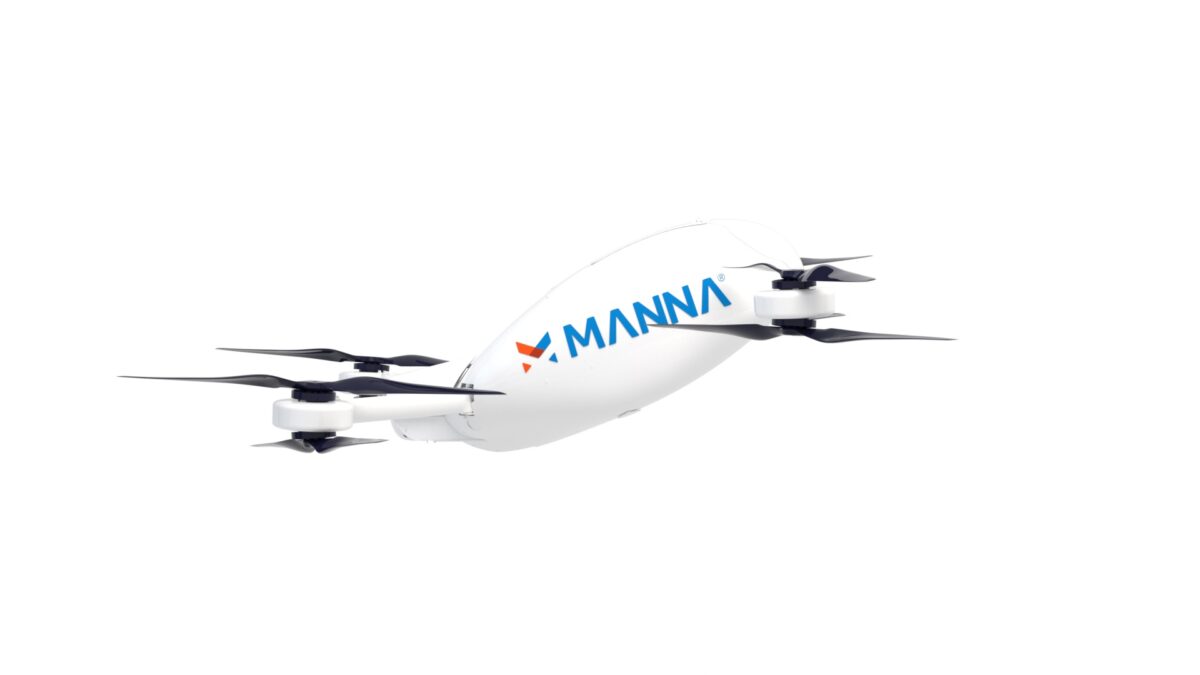Dublin-based drone delivery company Manna is planning to expand its service outside Ireland to both the United States and mainland Europe, according to two separate reports. The startup, which primarily delivers food and medicines, plans to fly in the U.S. as early as this year and in Europe as soon as 2023, Manna executives said.
Today, the company’s drones fly in the suburbs of Dublin and Galway. The aircraft, which resemble miniature quadcopters, reach speeds nearing 40 miles per hour and fly at an altitude between 164 and 252 feet, high enough to be relatively unnoticeable from the ground. They currently deliver food and medicine to around 45,000 people within three minutes, on average.
Andrew Patton, CEO of Manna’s U.S. business, told DroneLife that the company does “plan to be flying in the U.S. in 2022.” But there’s a caveat — Manna will be much more limited in the U.S. than in Europe.

Commercial drone regulations in the U.S. have steadily expanded over the years to include provisions around remote identification and operations over people. Yet U.S. provisions are still lagging behind those in Europe because they are lacking in one key area.
Flights that go beyond the visual line of sight (BVLOS) of the operator are essential to launching a commercial drone delivery service because they allow for drones to cover longer distances. Currently, the Federal Aviation Administration awards waivers to certain companies that allow them to conduct BVLOS flights at a small scale.
But more concrete rules are needed before widespread adoption can happen. That’s important in Manna’s case because as a non-U.S. company, it isn’t eligible to receive a waiver from the FAA. And even if it did, it would be limited to a delivery radius of only one or two miles.
“The challenge for us in the U.S. is that the regulatory environment is a bit behind what it is in Europe,” Patton told DroneLife.
“We have several issues under review right now,” he added. “The FAA’s view on what’s possible is being factored in. We will be pursuing waivers and exemptions to allow us to do as much as we can.”
Watch: Delivering everything with drones
Alphabet (NASDAQ: GOOGL) drone delivery subsidiary Wing, which Patton left last year to join Manna, has so far seen the greatest success working within the U.S. regulatory framework. The company earlier this month launched a commercial drone delivery service in the suburbs of Dallas-Fort Worth.
It could take years before Manna secures the regulatory approvals necessary to compete with Wing in the U.S. But in Europe, where Wing is Manna’s primary competitor, the Irish startup might have some immediate success.
Manna founder and CEO Bobby Healy told Forbes that the company plans to launch at a second Dublin location before the end of the year. It will then look to expand into mainland Europe next year.
“We’ve identified six European markets and 70 locations around those European markets that we’re going to roll out in 2023,” Healy said.
Manna’s early operations in the U.S. are likely to be small. But the regulatory structure in Europe could allow it to launch other services similar to those in Dublin and Galway, which have collectively completed over 65,000 deliveries, according to Manna’s website.
Related:
Read: The future of last-mile delivery includes drones
Read: Alphabet’s Wing launches commercial drone delivery in Texas
Drone regulations in Europe have gotten a recent boost from the European Union Aviation Safety Agency (EASA), the EU equivalent of the FAA. In Europe, drones are broken down into three categories — open, special and certified — that come with different limitations.
The open category is similar to the current regulatory regime in the U.S. These drones can be flown over people and at night and are limited by mass, altitude and the operator’s visual line of sight. Special and certified drones, however, can be used for on-demand commercial deliveries with authorization from the country where the operator resides.
In January 2023, European regulations could take yet another step forward. That month is the deadline for member states to establish what EASA calls U-space, defined as areas within which commercial drones can operate.
Healy was reluctant to share which countries and locations Manna might expand to next. But the company should have options. The eventual goal of EASA is to standardize drone regulations across EU member states, which would in theory open up the entire bloc to drone delivery services.
At the time of publication, Manna had not yet responded to Modern Shipper’s request for comment.
You may also like:
Wings over Texas: Flytrex drones delivering It’s Just Wings in Lone Star State
Nonprofit plans to use medical drones to save Ukrainian soldiers, civilians
Expanded drone delivery taxis toward takeoff with new FAA recommendations










